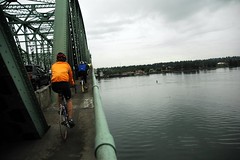[This article was written by Tony Fuentes. Fuentes is vice-chair of the Concordia Neighborhood Association, an avid outdoorsman, a father of two, and a small business owner. He is frequently called upon by city leaders and was a member of Commissioner Sam Adams’ Safe, Sound and Green Stakeholder Committee. Fuentes has a Masters degree in environmental and natural policy from Harvard where he also was a Teaching Fellow in economics.
In this article, he shares his view on how the Columbia River Crossing project would impact public health, natural areas, and our region’s economy.]

(Photo © J. Maus)
I count myself among the many residents of Portland who wants the Council to reject, not embrace, the “locally preferred option” for the Columbia River Crossing. Something must be done, and the proposed mega-bridge is something, but it isn’t the something that we need.
Spending billions of dollars to support expanded use of single occupancy vehicles (SOVs) is a throwback to a simpler time when climate change was science fiction, air pollution was symbolic of a city’s industrial might, and growth was boundless. The reality is that we cannot build our way out of our present transportation challenges with more pavement for SOVs. We have learned this already and we don’t need to relearn this now.
Some of the concern about the mega-bridge has been posited on effects on global climate change. However but there are much more localized concerns as well. This project will adversely effect the health and well-being of local residents and the local environment. And despite its high price tag, the bridge project will not help us create a durable local economy.
“This project will adversely effect the health and well-being of local residents and the local environment. And despite its high price tag, the bridge project will not help us create a durable local economy.”
The communities in North and Northeast Portland already bear the burden of our out-dated models for economic development.
The natural areas in this part of the city have been affected by existing and historic industrial uses since the city was founded. The thriving Columbia Slough habitat is now represented by “saved” pockets and hoped for habitat remediation projects, but pressure to move two steps backwards is always present (most recently the push from the Port of Portland to rezone Colwood from open space to industrial).
In addition to the loss of open space and the effect on local wildlife, residents in North and Northeast Portland along the I-5 corridor already endure some of the worst air quality in the region. The result of this is asthma rates that are twice the state and national averages (14 percent compared to 7 percent according to a survey conducted by researchers from Lewis and Clark College).
From the day the mega-bridge opens until the day it is once again filled with “unacceptable congestion,” we will still be burning gasoline. Accommodating more SOVs in the area means more pollution compromising local health from day one.
“…the City of Portland will be left on the sidelines until the CRC project staff hands us the keys to an Eisenhower-era solution.”
The Portland region needs to create a durable local economy. A economy that is contingent on more pavement for SOV use is simply not durable. For instance, we need effective freight mobility to support our local economy, but more lanes for trucks to share with SOVs doesn’t seem like a compelling response. Solutions that more firmly target freight mobility run the gambit from conversion of existing highway lanes to freight-only lanes, adding highway capacity only for freight, enhancement of rail corridors, and more.
If efficient movement of people to commercial and employment centers is the need, more space for people to travel alone doesn’t do much for creating a durable economy. Instead we will create a domino effect of inefficient land use: more local road expansion and parking development to accommodate more cars.
Rather than working to address the myriad of unresolved issues and ultimately shaping a solution that is fitting of our times and our future, I am worried that the City of Portland will be left on the sidelines until the CRC project staff hands us the keys to an Eisenhower-era solution.
Tell the Council to reject this project and create a real solution. Give them a call, drop them an email, come and testify on Wednesday [2pm at Council chambers, 1221 SW 4th].
We can do better.
— For more on the CRC, read the Portland Mercury’s coverage of today’s press conference or delve into the BikePortland archives.
— Also worth a read is Evan Manvel’s piece on BlueOregon, Will the city council make an informed decision on the MegaBridge?.


